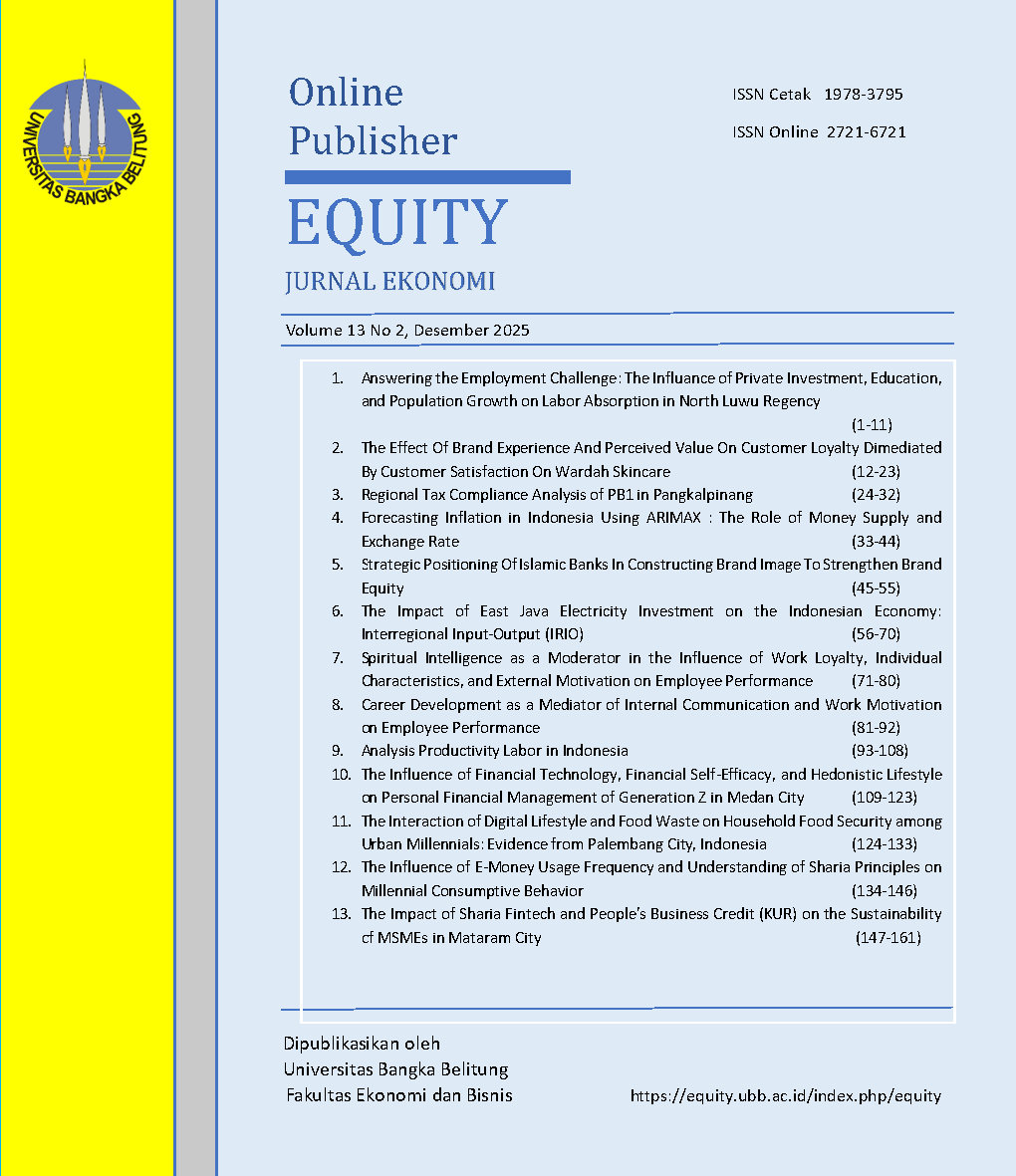Strategic Positioning Of Islamic Banks In Constructing Brand Image To Strengthen Brand Equity
DOI:
https://doi.org/10.33019/equity.v13i2.546Keywords:
Positioning, Brand Image, Islamic Bank, Brand Equity, Marketing StrategyAbstract
Islamic banking in Indonesia has significant potential, supported by a large Muslim population and a strong regulatory framework. However, its market share remains stagnant compared to international benchmarks such as Malaysia and Saudi Arabia. This study aims to examine positioning strategies of Islamic banks in strengthening brand image to improve brand equity and to identify factors behind their limited growth. Using a descriptive qualitative approach, the research draws on literature reviews and secondary data from the Financial Services Authority, Bank Indonesia, and academic sources between 2019–2024. The findings reveal that the market share target of 20% in the Sharia Banking Roadmap 2020–2025 has not been met, with actual achievement only 7.72% in 2024. The shortfall is driven by weak product differentiation—for example, financing schemes and savings products that closely resemble conventional banks—along with underdeveloped digital platforms, relatively high financing margins, and low public awareness of sharia-based values. Compared with Malaysia’s emphasis on digital innovation and Saudi Arabia’s integration of Islamic banking into national identity, Indonesia still relies heavily on “riba-free” narratives. This study contributes by integrating positioning, brand image, and brand equity analysis while drawing international lessons. The implications highlight the need for halal lifestyle positioning, digital service transformation, and cross-sector collaboration to build stronger brand equity and accelerate market growth.
Downloads
References
Aaker, D. A. (1991). Managing brand equity: Capitalizing on the value of a brand name. Free Press.
Ab Hamid, N. R. & others. (2023). The role of religious attributes in enhancing customer loyalty in Islamic banking. Journal of Islamic Marketing, 14(2), 324–340.
Afif, M., & Samsuri, A. (2022). Integration of Fintech and Islamic Banking in Indonesia: Opportunities and Challenges. Cakrawala: Jurnal Studi Islam, 17(1), 27–38. https://doi.org/10.31603/cakrawala.7051
Altaf, M., Iqbal, S., & Shafiq, M. (2017). Impact of brand awareness and perceived quality on brand loyalty: The mediating role of brand equity. International Journal of Business and Social Science, 8(1), 109–117.
Andespa, R., Yeni, Y. H., Fernando, Y., & Sari, D. K. (2024). Sustainable Development of Islamic Banks by Creating Islamic Branding: Challenges, Importance, and Strategies of Islamic Branding. International Journal of Sustainable Development and Planning, 19(2), 637–650. https://doi.org/10.18280/ijsdp.190221
Bank Indonesia. (2020). Sharia Banking Roadmap 2020–2025. Bank Indonesia.
Bank Negara Malaysia. (2023). Financial stability and payment systems report. Bank Negara Malaysia.
BPS. (2023). Pengukuran Kemiskinan Menurut Badan Pusat Statistik. https://www.bps.go.id/subject/23/kemiskinan-dan-ketimpangan.html
Cahyono and others. (2024). Corporate business strategy, CEO’s managerial ability, and environmental disclosure: The perspective of stakeholder theory. https://doi.org/10.1002/bse.3894
Hamid, A. & others. (2023). Brand equity in Islamic banking: Drivers and outcomes. Journal of Islamic Accounting and Business Research, 14(3), 512–530.
IFSB. (2024). Islamic financial services industry stability report 2024. Islamic Financial Services Board.
Inarawi, W., Djuwita, D., & Wahyuningsih, N. (2024). Comparing Pre and Post-Merger Performance of Bank Syariah Indonesia: A Maqashid Shariah Index Analysis. 1.
Jaafar, M., Rahman, A., & Hashim, N. (2021). Digital innovation and Islamic banking growth: Evidence from Malaysia. Asian Journal of Business Research, 11(4), 55–72.
Keller, K. L. (1993). Conceptualizing, measuring, and managing customer-based brand equity. Journal of Marketing, 57(1), 1–22.
Khudhori, K. U., & Hendri, L. (2021). . Islamic Banking and Fintech: Sustainable Collaboration Jel G21, G23. Al-Intaj: Jurnal Ekonomi Dan Perbankan Syariah, 7(2), 172-182.
Kotler, P., & Keller, K. L. (2016). Marketing management (15th ed.). Pearson Education.
Mukminin, A., & Latifah, S. (2020). Analisis ekuitas merek pada bank syariah: Studi empiris di Indonesia. Jurnal Ekonomi Syariah, 12(2), 145–160.
Musholikhodin, D. W., Adiansyah, Moh. D., & Farich, A. I. (2023). PENGARUH UKURAN PERUSAHAAN, KINERJA KEUANGAN, DAN KEPEMILIKAN PUBLIK TERHADAP KONSERVATISME AKUNTANSI PADA PERUSAHAAN JASA TELEKOMUNIKASI DAN PERDAGANGAN YANG TERDAFTAR DI BEI PERIODE 2020/2021. SENTRI: Jurnal Riset Ilmiah, 2(1), 223–229. https://doi.org/10.55681/sentri.v2i1.462
Nasreddine, B., & Damak, M. (2025). Islamic banking in Saudi Arabia: Growth, challenges and opportunities. S&P Global Ratings.
Otoritas Jasa Keuangan. (2024). Statistik Perbankan Syariah 2024. OJK.
Rachmawati, R., & Widana, I. (2019). Brand image and its impact on customer loyalty in Islamic banking. Jurnal Manajemen Dan Bisnis, 8(2), 85–99.
Sama, C. J. (2023). Strategies for Improving Small Farm Profitability in Sierra Leone.
Saputra, A. (2018). The effect of brand image on brand loyalty in Islamic banking sector. International Journal of Islamic Economics and Finance Studies, 4(2), 75–89.
Shalhoob, H. (2025). ESG Disclosure and Financial Performance: Survey Evidence from Accounting and Islamic Finance. Sustainability, 17(4), 1582. https://doi.org/10.3390/su17041582
Sudi, H. (2025). Digital transformation in Islamic banking: A roadmap for Indonesia. Journal of Islamic Finance Innovation, 7(1), 1–14.
Syahraeni, A., Kirana, L., & Sabbar, R. (2024). Product differentiation and positioning strategies in Islamic banking: Evidence from Southeast Asia. Journal of Islamic Marketing, 15(1), 66–84.
Syamlan, Y. T., Wahyuni, S., & Sudiharto, L. (2023). Concentration Level and Market Power of Islamic Bank Industry: Analysis of Pre and Post Bank Syariah Indonesia Merger. Journal of Islamic Economic and Business Research, 3(2), 138–160. https://doi.org/10.18196/jiebr.v3i2.189
Utami, R. & others. (2022). Post-merger market structure and competition in Indonesian Islamic banking. Asian Economic Journal, 36(3), 215–234.
Yuvita, M. & others. (2019). The effect of brand image on brand equity: An Islamic banking perspective. Jurnal Ekonomi Dan Bisnis Islam, 5(1), 45–59.
Downloads
Published
Issue
Section
License
Copyright (c) 2025 Agus Dadang

This work is licensed under a Creative Commons Attribution 4.0 International License.
Authors who publish journals in Equity: Jurnal Ekonomi agrees with the following conditions:
1. Authors retain copyright and grant the journal right of first publication with the work simultaneously licensed under a Creative Commons Attribution 4.0 International License.
2. Authors are able to enter into separate, additional contractual arrangements for the non-exclusive distribution of the journal's published version of the work (e.g., post it to an institutional repository or publish it in a book), with an acknowledgement of its initial publication in this journal.
3. Every publication (printed/electronic) are open access for educational purposes, research, and library. Other than the aims mentioned above, the editorial board is not responsible for copyright violation.













